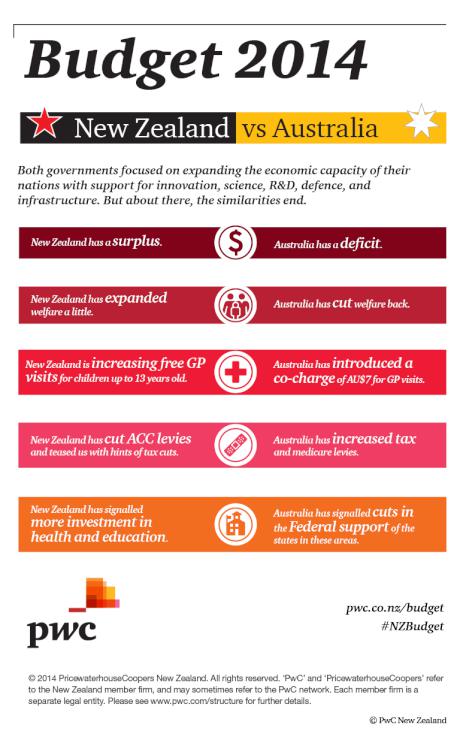Budget 2014: Ready To Rise? Summary & Infographics


Ready
to rise?
New Zealand Budget
2014
Summary
Despite carefully managed pre-Budget expectations, Budget 2014 has delivered two surprises: a surplus of $372m in 2015, significantly higher than the wafer thin surplus expected; and when taken over a four year period, higher planned new spending in health, education and welfare than was expected.
The higher surplus, despite extra spending, comes as a result of a forecast of strong economic growth of 3% in 2015 rising to 4% in 2016.
On the back of the strong economy, the
Government has announced it will increase new spending
in future budgets by around $1.5 billion a year, half a
billion dollars a year more than the 2014 budget allowance
of $1 billion.
Budget 2014 forecasts rising surpluses over the next four years reaching $3.5 billion in 2018. These surpluses are committed to future capital and infrastructure expenditure.
Net debt peaks at $65 billion and then is held there while the economy grows. As a result, net debt is forecast to have reduced to the Government’s target of 20% of GDP by 2020.
A range of areas have benefited from extra Government spending. Children and families have been a real target. As widely predicted, paid parental leave has been extended to 16 and then 18 weeks, and the parental tax credit has been increased to $220 a week. Free GP visits and prescriptions have been extended to children up to 13 and more funding provided for early childhood centres.
Health receives $1.8 billion of extra funding over the next four years in an attempt to feed our insatiable appetite for health services.
Critical to our long-term future as a nation, education receives a range of extra support from $359 million to fund the Prime Minister’s ‘super principal/teacher’ programme, to an extra $199 million more invested in tertiary education. Three new centres of research (CoR) excellence will be established bringing the total to ten.
Encouraging innovation through R&D is a theme that runs through Budget 2014 with measures such as the new CoRs, more contestable science and innovation funding and modest tax relief for R&D companies.
Auckland infrastructure gets another boost with $375 million of additional capital funding for NZTA which will accelerate $815 million of new projects.
Another $1bn of the funds raised from the SOE floats was committed to various capital projects including schools, hospitals and KiwiRail.
The forecast projections show a reduction in the relative size of expenditure on the public service, which will keep the discipline on ‘reprioritisation’ of expenditure to fund new initiatives.
As expected, there was no softening of the Prime Minister’s political commitment to universal national superannuation from the age of 65.
Overall, Budget 2014 tries to strike a balance between returning to sustainable surpluses, allowing some more spending on key areas of need, and providing the fiscal backdrop to support economic growth. We think it largely achieves that.
Yet,
after the December 2013 Budget Policy Statement, we saw five
important challenges for Budget 2014. So how did it deliver?
...
Full doucment: Ready
to rise?
New Zealand Budget
2014


 NIWA: Flooding From Underneath - New Tool Reveals Shallow Groundwater Elevations
NIWA: Flooding From Underneath - New Tool Reveals Shallow Groundwater Elevations Commerce Commission: Commission Concludes Auckland Airport Over-charging By $190 Million
Commerce Commission: Commission Concludes Auckland Airport Over-charging By $190 Million The Future Is Rail: Ferry Decision - Common Sense Prevails
The Future Is Rail: Ferry Decision - Common Sense Prevails Aotearoa Food Rescue Alliance: Grocery Market Reform Must Include Mandatory Food Rescue Partnerships
Aotearoa Food Rescue Alliance: Grocery Market Reform Must Include Mandatory Food Rescue Partnerships Hugh Grant: Zero Trust Security - A Buzzword Or The Ultimate Protection?
Hugh Grant: Zero Trust Security - A Buzzword Or The Ultimate Protection? Bill Bennett: Comcom revisits fibre rules as competition intensifies
Bill Bennett: Comcom revisits fibre rules as competition intensifies



